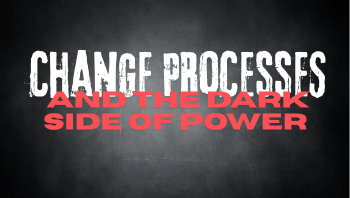The dark side of power. What this means for change processes and what managers need to do.
In recent articles, we have discussed power, influence, and interests as neutral, inherent control variables in every organization. However, anyone who leads or changes organizations knows that power is not just a neutral instrument. It can be abused.
Power games, self-promotion, subtle sabotage: these are precisely the dark sides that are not operational accidents in complex systems, but systemic patterns of human behavior.
The dark factor in the executive suite
Change always encounters people who understand power not as a shared responsibility but as a personal resource and use it deliberately. They do not seek the best solution, but rather the position in which they can control, interpret, and decide. And they know the weak points of the system: they use informal networks, create ambiguity, and shift responsibilities.
This is not always malicious, but it is often extremely effective, especially when they are on their way to the top.
The research is clear here: people with narcissistic, Machiavellian, or psychopathic personality traits (dark triad) are disproportionately represented in top management positions. They maneuver themselves into these positions because they:
- Actively seek power.
- Are persuasive (often interpreted as “charismatic”).
- Show little hesitation in strategically outmaneuvering others.
The “D factor”: The common core of darkness
To make this dynamic more tangible, psychologists at the University of Ulm introduced the D factor (Dark Factor of Personality) in 2018. This psychological construct describes the common root of these dark traits: the willingness to assert one's own interests, even if others are harmed in the process.
According to estimates, around ten percent of the population exhibit above-average levels of this trait. In complex, dynamic organizations, i.e., precisely where change managers work, this factor has a disruptive effect.
👹 Would you like to know your own D-factor? You can take the self-test here and contribute further data to the study: D-factor self-test
The Achilles' heel of change: uncertainty as a lever of power
Change is the ideal breeding ground for dark power strategies. Uncertainty and ambiguity create a vacuum that people with strong self-interest can fill.
In phases of transformation, they can become “silent tipping points” if they attempt to control information flows or build strategic alliances in order to subtly divert or slow down processes rather than openly blocking them.
Here are a few typical patterns of covert power exercise in change processes:
- Dosing information. Goal: Securing interpretive authority, weakening others. Consequence for Change: Lack of commitment, rumors, paralysis of decision-making ability
- Obscuring decision-making processes. Goal: Creating opacity as a playground. Consequence for Change: Blurring responsibilities, overturning processes without the cause being identifiable.
- Shifting loyalties. Goal: Overturning majorities, binding key people. Consequence for Change: Functioning alliances break up, necessary support is lost
- Allowing conflicts to escalate. Goal: Distracting or strengthening one's own position. Consequence for Change: Focusing on internal skirmishes instead of the transformation goal.
These strategies are rarely loud. They are subtle, systemic, and often effective.
And now? Ways for change managers to turn this dynamic around behind the scenes
(If you have read our previous articles in this series, you know that this is no different from how we would advise dealing with “power” in general :-)
The ‘dark’ version of power cannot be “moderated away.” But you can prevent it from taking control of your change. This is not a moral question, but one of change architecture and leadership clarity.
Four strategic levers for leadership, OE, and change managers:
- Sharpen decision-making architectures: Lack of transparency is the oxygen for power games. Define crystal-clear, transparent decision-making paths and responsibilities. Leave no doubt about who decides what and when.
- Make informal channels of influence visible: Where and how do rumors arise? Who talks to whom? Leadership must be able to read the informal maps of power and actively incorporate them into management.
- Dispel the taboo surrounding power: Stop viewing power as “dirty.” Power must be identifiable and negotiable. Openness and constructiveness can only prevail if the hidden and dark aspects are no longer hushed up.
- Strategically strengthen alliances based on trust: Consciously build alliances based on trust, common goals, and proven performance—and deliberately counter these alliances with those players who rely on manipulation and self-interest.
Conclusion:
If you really want to lead change, you have to see both sides: the open and the hidden, the constructive and the dark.
If you don't also consider the dark side of power, it will take you by surprise. If you understand it, you remain capable of acting and shaping things. That is the core of effective leadership in transformation. Of course, we are not naive: there is no guarantee of success, but it is a worthwhile attempt!
This concludes our current focus on the topic of “Power in Change Processes.” We look forward to your feedback and, above all, your best practices in dealing with this topic!
Sources:
Dark Triad: Volmer, J., Koch, I. K., & Wolff, C. (2021). The positive connection between dark triad traits and leadership. Springer.
D factor: Moshagen, M., Hilbig, B. E., Zettler, I.: The Dark Core of Personality. In: Psychological Review, Vol 125(5), Oct 2018, 656-688; dx.doi.org/10.1037/rev0000111


About me

All Rights Reserved
Get in touch
-
+49-(0)941 600 93 003
-
This email address is being protected from spambots. You need JavaScript enabled to view it. -
Thomas_Huber
ToChange Gmbh
-
Thomas Huber
-
Traubengasse 6
-
D-93059 Regensburg

